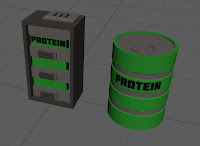I implemented the mouse interacting with the gameworld, to a minor extent. If I want to continue this way around I'm going to have to rethink things in terms of how the gameworld actually fits together. I had intended for the player to be able to place buildings free form in the game world, but will have to maybe revert to a more traditional grid system.
Also billowing smoke in the middle of the terrace is a modified version of the truck I've used so much of. They're going to be worked on a lot more, and I'm going to have to watch Mad Max: Fury Road for better inspiration, because that's going to be the vehicle of choice for the many many bandits and raiders attacking your export trucks leaving your settlement.
Something else I've added is the ability to pan the camera around a central pivot. I need to work on it a little more as it doesn't actually adjust how the camera moves around the world, meaning that edge scrolling and the WASD keys don't move the camera in the direction you'd expect.
I've also written up some more of the late-game ideas and features I want to implement.
Discontent
Discontent is used to facilitate growth and building of structures. Discontent is a percentage scale from 0-100%. Intervals of 10-20% add new penalties to the game world, ranging from increased resource use to lower production. A discontent score of 100% is one of the games fail states. Discontent rises with certain things. Some buildings will provide a service whilst raising discontent, high populations will raise discontent, having low to no food stored will raise discontent. The Discontent mechanic exists to curb building beyond the limits of the money system, as building up too quickly will cause your citizens to riot. However some buildings like the Propaganda Centre and the Documentary Studio have higher outputs if operating under high levels of discontent.Panoptic Nexus
The ‘city hall’ of the Bleak world. The starting point of every city. The Panoptic Nexus is situated in the centre of the map, and grows and develops with each and every profit milestone. Upgrading the Nexus unlocks new edicts, which bolster and change how other buildings and features work.Milestones
akin to the milestone unlocks in Cities skylines, but instead of based on population, they’re based on currency, either in terms of profit, or balance. Per trade Profit makes more sense as balance can be idled and cheatedEdicts
Edicts are similar to the feature in Tropico which shares its name. Edicts are a way for the player to customise your settlements code of laws, for fun and mostly profit.Populational Needs
the pairs of diametrically opposed groups both have maslovian pyramids, however one of them is markedly more complex than the other.(Science > Luddite) (Criminal > Prisoner) (worker > Unemployed)
The less complicated side to the pair does not have a victory state assigned to it, although the victory state of the more complicated side of the pair can only be achieved late in the game, and requires a lot of resources and capital to be invested.
Gameplay Tiers.
Gameplay is broken into three tiers. The first tier is where the game starts, providing the player with a basic set up that will keep a small population stable for a reasonable amount of time. However the player will have to expand and grow the settlement as currently it will not be profitable. In addition their population will grow slowly, accelerating during migration waves. This means the player will have to expand infrastructure to support their burgeoning population.This leads into the second tier. At this point the player will have some form of export base, and will at least be breaking even. This tier opens up more production options, including the second stages of many production lines. However at this point, the discontent mechanic comes into play. The player then has to expand on infrastructure further, to ensure that the settlement doesn’t riot and tear itself apart. Additionally the player can now begin to specialise their settlement through focusing on specific population groups and passing specific edicts. Once the player has placated the population enough that immediate riots are no longer an issue, the game opens up into its final tier of play.
The third tier greatly expands on the population groups, with three of the six having victory conditions, the opposite three being without, but to make up for that they’re simpler and require less ‘upkeep’ choosing one or more of those three allow the player to focus on alternate win conditions through the contracts system.
















